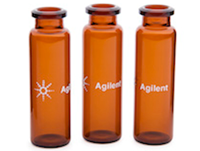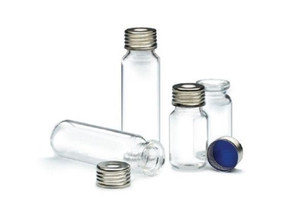Posted by Chrom Tech on 14th Oct 2025
How To Choose the Right Headspace Vial Cap
Why Choose Headspace GC?
Headspace gas chromatography (GC) is a widely used analytical method for detecting volatile organic compounds (VOCs) such as alcohols, solvents, residual monomers, and flavor compounds. This technique is especially common in applications like blood alcohol analysis, pharmaceutical testing, and food quality control.
In headspace GC, analytes are typically more volatile than the sample matrix, allowing them to partition into the gaseous “headspace” above the sample in the vial. Only this gas phase is injected into the GC column, eliminating matrix interferences and extending instrument longevity. Because these samples are pressurized during equilibration, headspace vials and caps are engineered to withstand internal pressure and maintain a tight seal under heat.

Choosing the Right Headspace Vial
Headspace vials are typically available in 10 mL and 20 mL sizes, with both clear and amber glass options to accommodate light-sensitive samples. Selecting between flat-bottom and round-bottom designs depends on your autosampler’s configuration:
- Round-bottom vials are ideal for autosamplers where the needle enters the vial. The curved base promotes even heating and pressure distribution.
- Flat-bottom vials are used when the vial is lifted to the needle or when stability on flat surfaces is required.
Additionally, the type of autosampler you use determines whether you’ll need screw thread or crimp-top vials:
- Screw thread vials (typically 18 mm caps) are common for instruments that use magnetic handling, such as CTC/Combipal autosamplers.
- Crimp-top vials (20 mm caps) are preferred for robotic arm autosamplers that require a rigid ledge for gripping. Crimp-top seals are known for providing the most leak-tight closure—essential for volatile analytes.
Selecting the Proper Headspace Cap
Once you’ve chosen your vial type, you’ll need a compatible cap and septa combination. The first step is determining the vial’s closure type:
- If the vial has visible threading, select a screw cap that matches the thread pattern.
- If not, pair it with a crimp cap and seal it using a manual or electronic crimping tool.
Note that screw caps are not compatible with robotic arm autosamplers, as they lack the gripping edge required for automated vial transfer. Autosamplers with magnetic transport mechanisms, however, require magnetic screw caps (18 mm).
Crimp caps are typically aluminum and come in several variations:
- Standard aluminum crimp caps
- Pressure-release lined crimp caps for added safety
- Magnetic crimp caps compatible with robotic handling systems
Finally, select the appropriate septa material based on your temperature and solvent conditions:
- PTFE/Silicone: The most common combination for general-purpose use
- PTFE/Butyl: Offers excellent chemical resistance and re-sealability
- High-Temperature Septa: Designed for elevated headspace equilibration temperatures
If you’re uncertain about vial, cap, or septa compatibility, Chrom Tech’s technical specialists can help you find the right configuration for your autosampler and analytical workflow. Contact our support team for expert recommendations.
Frequently Asked Questions About Headspace GC Vials
What is the main advantage of headspace GC?
Headspace GC allows only volatile compounds to enter the GC column, reducing contamination from non-volatile sample components and improving reproducibility in trace-level VOC analysis.
Should I use a screw thread or crimp-top headspace vial?
It depends on your autosampler. Robotic arm autosamplers typically require crimp-top vials, while magnetic autosamplers like Combipal use screw-thread vials with magnetic caps.
What size headspace vial should I choose?
Most headspace applications use 10 mL or 20 mL vials. The choice depends on your sample volume, autosampler compatibility, and method requirements for vapor-to-liquid ratio.

